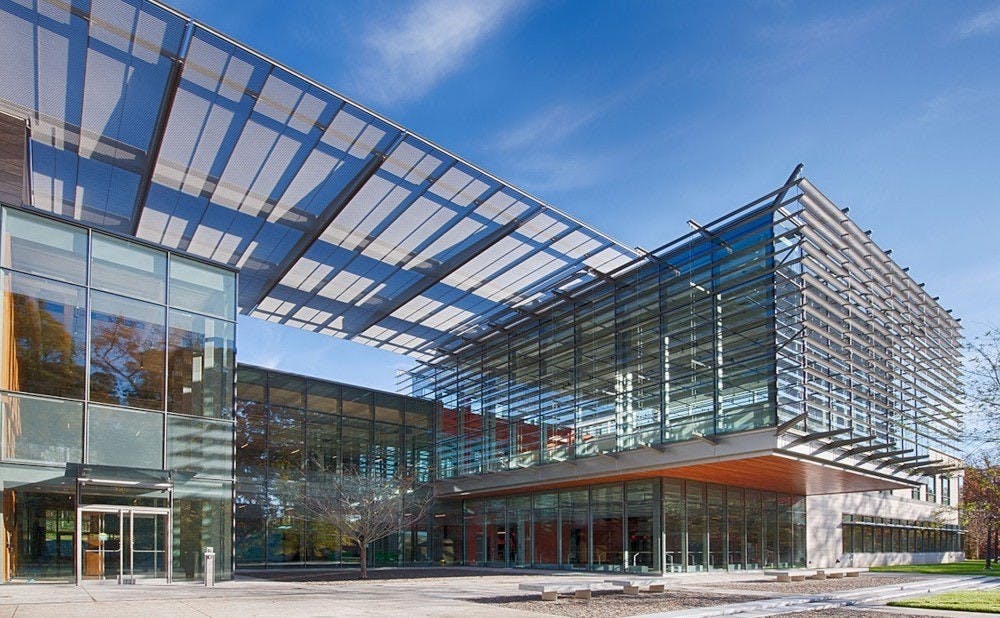Students often come to know their professors over the course of a semester-long class, where instructors serve more as mentors and advisors than writers, researchers or filmmakers. The 2019 AMI Faculty Filmmaker Spotlight, held this past Thursday at the Rubenstein Arts Center, highlighted the role of AMI professors as artists in their own right through a screening of their most recent filmmaking projects.
Some works are concept driven, offering a peephole into a larger theme. Alex Cunningham’s “Lovemoon Battlefield,” a multi-projector performance, is a recurring experiment that attempts to stoke narrative out of a random selection of footage and poetry. As part of his performance, Cunningham projects onscreen a series of 1-minute film-clips, which include outtakes from his previous works as well as several footage selections specially filmed for this project. He pairs each clip with a randomly selected verse from Frank Stanford’s 15,283-line epic poem, “The Battlefield Where The Moon Says I Love You.”
Before the performance, Cunningham described “Lovemoon Battlefield” as an attempt to prod at the moviegoer’s engrained desire and expectation for narrative. When verse and film serendipitously coincide in theme or sequential clips fall spontaneously into one another, the very human capacity of the viewer to make something out of nothing is made explicit.
“We’re so trained in watching narrative film that flows a certain way,” Cunningham said at the screening. “If someone holds up a lemon, the lemon means something, and maybe the next shot will have something to do with the lemon. But [experimental filmmakers] are now playing with shots and sequences that suggest a story but totally deny you that pleasure of something actually happening."
Other faculty pieces veer into commentary that is less abstract and more socially and historically rooted. Shambhavi Kaul’s pairing of the video loop “Safe Travels” and her reading of “In Flight,” an original collage poem consisting of excerpts from in flight magazines, recreates the daze of a long airplane flight while simultaneously questioning the ethics of tourism. Both pieces are part of Kaul’s larger gallery show that examines airplane spaces and the meaning of travel.
“Post 9/11, we have a whole new way of thinking about travel, especially for people who come from different backgrounds, and are now pigeon-holed under a new race that has emerged called 'brown,'” Kaul said in an interview with Mid-day.com. “In the abstract spaces of airplane travel and transit for this group, it would seem 'tourist' and 'terrorist' are uncomfortable subjectivities that are offered in equal measure.”
Kaul’s screening at the Faculty Filmmaker Spotlight offers a small sample of this greater work. “Safe Travels,” which simulates looking out the window of an airplane onto a deserted island, feels hypnotic and trance-like, open-ended in a way that allows you to transpose almost any narrative on top of it. “In Flight” shapes meaning and story out of this landscape: It evokes colonial histories with magazine excerpts that present their publicized destinations as off-the-beaten-path paradises that are up for the taking.
“One narrative is about the exotic tourist destination that you’re going to, but there’s also this other narrative that seems colonial, that talks about natives and colonies,” Kaul said. “There’s this idea of the world being something that’s up for grabs. In a way, you could call [“In Flight”] a humorist critique of in flight magazines.”
Gary Hawkins’ “The Accidental Man” evokes its own kind of hypnotic state, one that is encased in the screen of an old-time television set rather than in the stagnancy of an airplane. Set in the 1960s, the film follows a young boy who joins his plumber father on a trip to repair a leak in a local home. As hard feelings bud and quarrels ensue among his father and the adults of the household, the boy finds refuge in a remake of the old science fiction movie “Teenagers from Outer Space.” Hawkins’ short film stays true to the aesthetics of its setting, recreating a time and place that houses another context: the innocent revelry of an adventure in space.
While Cunningham, Kaul and Hawkins’ projects are threaded through with some kind of narrative — albeit one that can be narrow at times — other pieces feel more perceptual, palpable and aesthetic. Anna Kipervaser’s untitled 2018 16mm film plays with motion and light, seamlessly melding together clips as disparate as flashing carnival lights, shifting black and blue abstract images and flowing water. Bits of film fall into one another in ways that are conceptually distinct but aesthetically consistent.
In discussing her process of filmmaking, Kipervaser said, “When I’m shooting, I don’t know the film that the footage will fit into, if any at all. I generally shoot for the love of shooting, and I trust the process.”
Other films included in the Faculty Spotlight were Lisa McCarty’s digital selection of photosites, Kamara Thomas’ music video “Good Luck America” with filming and editing by Jim Haverkamp and the short film “Between Dreams” with cinematography by Steve Milligan. All the projects showcased at the spotlight demonstrated the diversity of thought and approach among AMI faculty, offering a sampling of the work that goes on in the department and revealing talents and insights that students might want to be privy to.
Get The Chronicle straight to your inbox
Signup for our weekly newsletter. Cancel at any time.

